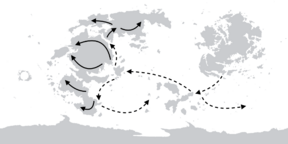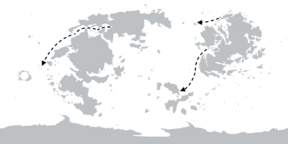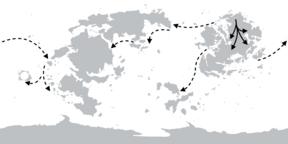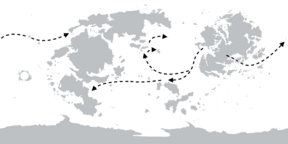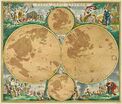History of migration on Eurth: Difference between revisions
m (→Modern migrations: +rewrite) |
m (→Classical migrations: +intro +links ∆spelling) |
||
| (One intermediate revision by the same user not shown) | |||
| Line 63: | Line 63: | ||
}} | }} | ||
* 1200 BCE: [[Medanese Empire|Medanese]] traders travelled westward across the [[Oriental Ocean]] and beyond. Even though the [[Strait of Saeida]] were supposed to be impassable, the little ships were brave enough to go through them and | The Classical migrations period, spanning broadly from 1200 BCE to 300 CE, stands as an indication of the enduring human spirit of exploration, adaptation, and survival. This epoch, illustrated by the accompanying map, witnessed the traversing of uncharted waters, the establishment of nascent cultures, and the forging of unprecedented trade routes, shaping the civilizations of [[Eurth]] in profound ways. | ||
* 1200 BCE: {{flagicon|Orioni}} [[Medanese Empire|Medanese]] traders travelled westward across the [[Oriental Ocean]] and beyond. Even though the [[Strait of Saeida]] were supposed to be impassable, the little ships were brave enough to go through them, and sailed onward into the open [[Adlantic Ocean]]. From there, they went to [[Yuropa]] to get ivory and gold. Their trade routes might have reached as far as [[Tagmatium]], or perhaps even beyond. | |||
* 900 BCE: {{flagicon|Variota}} Proto-Aloorian culture in Europa starts as various smaller groups are forced towards the sea by larger clans and realms. The proto-Aloorians focus on seafaring and the sea in general, seeing it as a new opportunity and a way to get away from their enemies. | * 900 BCE: {{flagicon|Variota}} Proto-Aloorian culture in Europa starts as various smaller groups are forced towards the sea by larger clans and realms. The proto-Aloorians focus on seafaring and the sea in general, seeing it as a new opportunity and a way to get away from their enemies. | ||
* 800 BCE {{flagicon|Variota}} First evidence of a single proto-Aloorian language, further aiding trade and knowledge sharing between the various areas. Organised religion starts playing a role as a singular, unified language enabled sharing the oral traditions of the various groups. | * 800 BCE {{flagicon|Variota}} First evidence of a single proto-Aloorian language, further aiding trade and knowledge sharing between the various areas. Organised religion starts playing a role as a singular, unified language enabled sharing the oral traditions of the various groups. | ||
* 500 BCE: {{flagicon|Variota}} Some untold disaster forces proto-Aloorians groups to come together and merge, heavily increasing the population density and forcing creative solutions for homelessness among new inhabitants. | * 500 BCE: {{flagicon|Variota}} Some untold disaster forces proto-Aloorians groups to come together and merge, heavily increasing the population density and forcing creative solutions for homelessness among new inhabitants. | ||
* 441 BCE: [[Andalla#Great Departure (Utgang)|Great Departure (Utgang)]] of Sjådska to Altaria | * 441 BCE: [[Andalla#Great Departure (Utgang)|Great Departure (Utgang)]] of Sjådska to [[Altaria]]. | ||
* 59 CE: An [[Aroma]]n merchant vessel, blown off its course, lands in [[Marenesia]]. Its wreck was found at the bottom of $Name Bay near [[Deopolis]], [[Salvia]].<ref>Walter Sullivan, [https://www.nytimes.com/1982/10/10/world/rio-artifacts-may-indicate-roman-visit.html Rio artifacts may indicate Roman visit], The New York Times, 10 October 1982</ref> {{wp|Amphora}}s found in the ship are in fact similar in shape to jars produced in {{wp|kiln}}s at Tellakois, on the west coast of [[Adaptus]]. | * 59 CE: An [[Aroma]]n merchant vessel, blown off its course, lands in [[Marenesia]]. Its wreck was found at the bottom of $Name Bay near [[Deopolis]], [[Salvia]].<ref>Walter Sullivan, [https://www.nytimes.com/1982/10/10/world/rio-artifacts-may-indicate-roman-visit.html Rio artifacts may indicate Roman visit], The New York Times, 10 October 1982</ref> {{wp|Amphora}}s found in the ship are in fact similar in shape to jars produced in {{wp|kiln}}s at Tellakois, on the west coast of [[Adaptus]]. | ||
* 125 CE: Great Aroman Migration to [[Sanctum Imperium Catholicum]]. | * 125 CE: {{flagicon|Salvia}} Great Aroman Migration to [[Sanctum Imperium Catholicum]]. | ||
* 288 CE: After a failed coup attempt in the [[Aroman Empire]], the | * 288 CE: {{flagicon|Kirvina}} After a failed coup attempt in the [[Aroman Empire]], the instigator [[Kirvina#History|Lysandros Tagaris]] and his followers are forced to flee. Lysandros authorized a journey west, chasing rumours of islands that could be settled there. Favourable currents and good wind brought the Lysandrian Fleet in sight of [[Aurelia]] within weeks, sweeping it around the Cape before winter set in and landing it near the modern city of [[Kirvina#History|Coeaneia]]. | ||
=== Post-Classical migrations === | === Post-Classical migrations === | ||
| Line 89: | Line 91: | ||
}} | }} | ||
* 704: The Siege of Arome | The Post-Classical migrations represent a pivotal era in the annals of history, marked by extensive movements of people across the continents of Eurth. This period was characterized by a series of significant events, explorations, and societal shifts that unfolded between the 7th and 14th centuries. The migrations were driven by a variety of factors including religious upheavals, quests for power, climatic changes, and the innate human desire to explore the unknown. | ||
* 760-880: During the Mikoto period ({{circa|760{{snd}}880}}), the Orinese Empire reached the height of its power. Trade flourishes, enabling the dynasty to finance of expeditions into the [[Oriental Ocean]]. Empress Yomiro II, intrigued by reports of a great current and seeing an opportunity for wealth, assembles a fleet to explore new lands. She raised a fleet of 1,000 ships and prepared to find and settle whatever new land this current might sweep her to. She left her sister Ahe IV in charge of the empire and dropped her sails. Neither Empress Yomiro II nor any of her ships were ever heard from again. Despite her disappearance, this period sets the stage for [[Orioni]]'s golden age, marked by prosperity and cultural advancements. | |||
* 704: The [[Siege of Arome]] concluded when Pope Calrissius I fled from [[Tagmatium]] to [[Salvia]]. This event symbolized the [[Enlightened Aroman Church]] becoming the new [[State Church of Arome]], altering the religious landscape of the region and leading to significant socio-political changes. | |||
* 760-880: During the [[Mikoto period]] ({{circa|760{{snd}}880}}), the Orinese Empire reached the height of its power. Trade flourishes, enabling the dynasty to finance of expeditions into the [[Oriental Ocean]]. Empress [[Yomiro II]], intrigued by reports of a great current and seeing an opportunity for wealth, assembles a fleet to explore new lands. She raised a fleet of 1,000 ships and prepared to find and settle whatever new land this current might sweep her to. She left her sister [[Ahe IV]] in charge of the empire and dropped her sails. Neither Empress Yomiro II nor any of her ships were ever heard from again. Despite her disappearance, this period sets the stage for [[Orioni]]'s golden age, marked by prosperity and cultural advancements. | |||
* 887: Olrik {{wp|Naddodd}}son, exiled from [[Thelarike]] due to his violent actions, pioneers a [[Burania]]n exploration into the [[Adlantic Ocean]], expanding the geographical knowledge of the time and opening new possibilities for trade and exploration. | * 887: Olrik {{wp|Naddodd}}son, exiled from [[Thelarike]] due to his violent actions, pioneers a [[Burania]]n exploration into the [[Adlantic Ocean]], expanding the geographical knowledge of the time and opening new possibilities for trade and exploration. | ||
* 890: An [[Ateenia]]n expedition in Eastern [[Aurelia]] | * 890: An [[Ateenia]]n expedition in Eastern [[Aurelia]] established a temporary colony in modern [[Louvier]], encountering and clashing with the native populations. The expedition faced decimation due to diseases, highlighting the challenges of early exploration and colonization efforts. | ||
* 900-1400: The tenth century was the start of the {{wp|Little Ice Age}}, a disruption in glubal climatic patterns. This resulted in generally cooler and wetter temperatures. These strongly affected the rainy season. In the fourteenth century, this manifested into a general trend of intense colds and snowfall in the polar steppes, irregular droughts in temperate climates, and seemingly unending rainfall in subtropical areas.<ref>[https://www.youtube.com/watch?v=iCgGoYGjeds How the Mongols Lost China] by Kings and Generals (9 January 2022)</ref> It had a significant impact on farming harvests. This, in turn, led to increased conflict, human migration, spread of disease. Certainly not a good time to be alive. | * 900-1400: The tenth century was the start of the {{wp|Little Ice Age}}, a disruption in glubal climatic patterns. This resulted in generally cooler and wetter temperatures. These strongly affected the rainy season. In the fourteenth century, this manifested into a general trend of intense colds and snowfall in the polar steppes, irregular droughts in temperate climates, and seemingly unending rainfall in subtropical areas.<ref>[https://www.youtube.com/watch?v=iCgGoYGjeds How the Mongols Lost China] by Kings and Generals (9 January 2022)</ref> It had a significant impact on farming harvests. This, in turn, led to increased conflict, human migration, spread of disease. Certainly not a good time to be alive. | ||
* 1012: The Great Voyage of Captain Alaric Stormwind | * 1012: The Great Voyage of Captain [[Alaric Stormwind]] began. Alaric, a renowned navigator from [[Thelarike]], embarked on a daring journey across the uncharted waters of the [[Sea of Storms]] in search of new lands and civilizations. His fleet of five ships encountered fierce storms, mythical creatures, and unknown territories. The voyage resulted in the discovery of the island of present-day [[Korinon]] and [[Corinium]]. These would later become crucial for trade and cultural exchange between [[Europa (continent)|Europa]] and [[Argis]]. | ||
* 1250: The migration of [[Burania|Buran people]] from the Central Europan Steppes | * 1250: The migration of [[Burania|Buran people]] from the Central Europan Steppes exemplified the dynamic nature of population movements during this period, reshaping demographic and cultural landscapes in the regions they traversed. | ||
=== Early modern migrations === | === Early modern migrations === | ||
Latest revision as of 06:38, 22 September 2023

The history of human migration on Eurth refers to the movement by humans from one geographical area to another with the intentions of settling, permanently or temporarily, in a new location. The movement is often over long distances and from one country to another, but internal migration is also possible; indeed, this is the dominant form glubally.
Migration involves significant cultural, economic, political, and social change for both the migrants themselves and the populations in the destination location. The driving forces behind migration include economic, social, political, and environmental factors.
History
The history of human migration is a long and complex one, dating back to the Stone Age. Over time, humans have spread to all corners of the glube, following a variety of routes and motivations.
Prehistoric migrations
The history of human migration extends back to the earliest periods of human history. One of the earliest human migrations was the out-of-Azania migration, which occurred between 500,000 and 100,000 years ago. The prehistoric migration of the Homo genus out of Azania is considered to be the first significant instance of human migration. This migration saw modern humans (Homo sapiens) leave Azania and spread across Memopotamia, Amutia, and eventually the rest of Europa.
Another major human migration was the maritime spread of Azano-Marenesian peoples across the Eurth during the Palaeolithic period. During the last glacial maximum (50 kya), the sea level was probably more than 110 meters lower than today. When glaciers advance and the climate is colder, glaciation occurs and sea levels drop. And when the climate is warmer, glaciers retreat, and sea levels rise, ushering in an interglacial period which is what we’re in right now.[1] The first humans used this lower sea level to reach Marenesia and then Alharu. It is believed that humans crossed this area in canoes. This ocean crossing is one of humanity’s important early achievements, even if it’s wrapped in mystery because no written records of this Cigarun civilization have been discovered. The migration was a significant event, as it was the first time that humans had settled on a continent that was completely isolated from other landmasses. Heading south from Noble Nykia, with assistance from ocean currents and prevailing winds, there exists an advantageous ‘ocean highway’ with ideal conditions for island hopping.[2]
- c. 80,000 BCE: Azano-Marenesian peoples move to Meteorolas.
- c. 50,000 BCE: Azano-Marenesian peoples move to Marenesia.
- c. 13,000 BCE (15,000 years ago): Azano-Marenesian peoples move to Alharu.
- c. 13,000 BCE: Modern humans first arrived at the Ketek Peninsula after migrating from across the continent of Alharu.
- c. 8,000 BCE (10,000 years ago): Azano-Marenesian peoples move to Aurelia and Argis.
Subsequently, the advent of agriculture led to substantial population movements in many parts of the wurld.
- XXXX BCE: Transadlantic trade to Memopotamia.
- c. 4000 BCE: Proto-Xaraian tribes in the 4th millennium BCE. Spread across Central Argis in what is now modern-day Ahrana and parts of east Dniester, the Proto-Xaraian tribes were strategically positioned in between the Mediargic and Canamo seas.
Another, more controversial theory about the peopling of the New Wurld theories that humans could have migrated by boat from northwestern Europa to Argis, following the drifting ice of the North Adlantic Ocean. This theory is quite popular in Dolchland, but no serious scientists give this idea any credence.[citation needed]
WIP
- First wave is always slow, because there is nothing to build upon and everything has to be started. For example: Azano-Marenesian peoples in Alharu. Stick around the coast, then move inland.
- Second wave is faster, allows trade, because at least some ports exist. For example: Memopotamians in Marenesia. Only coastal explorations.
Classical migrations
The Classical migrations period, spanning broadly from 1200 BCE to 300 CE, stands as an indication of the enduring human spirit of exploration, adaptation, and survival. This epoch, illustrated by the accompanying map, witnessed the traversing of uncharted waters, the establishment of nascent cultures, and the forging of unprecedented trade routes, shaping the civilizations of Eurth in profound ways.
- 1200 BCE:
 Medanese traders travelled westward across the Oriental Ocean and beyond. Even though the Strait of Saeida were supposed to be impassable, the little ships were brave enough to go through them, and sailed onward into the open Adlantic Ocean. From there, they went to Yuropa to get ivory and gold. Their trade routes might have reached as far as Tagmatium, or perhaps even beyond.
Medanese traders travelled westward across the Oriental Ocean and beyond. Even though the Strait of Saeida were supposed to be impassable, the little ships were brave enough to go through them, and sailed onward into the open Adlantic Ocean. From there, they went to Yuropa to get ivory and gold. Their trade routes might have reached as far as Tagmatium, or perhaps even beyond. - 900 BCE:
 Proto-Aloorian culture in Europa starts as various smaller groups are forced towards the sea by larger clans and realms. The proto-Aloorians focus on seafaring and the sea in general, seeing it as a new opportunity and a way to get away from their enemies.
Proto-Aloorian culture in Europa starts as various smaller groups are forced towards the sea by larger clans and realms. The proto-Aloorians focus on seafaring and the sea in general, seeing it as a new opportunity and a way to get away from their enemies. - 800 BCE
 First evidence of a single proto-Aloorian language, further aiding trade and knowledge sharing between the various areas. Organised religion starts playing a role as a singular, unified language enabled sharing the oral traditions of the various groups.
First evidence of a single proto-Aloorian language, further aiding trade and knowledge sharing between the various areas. Organised religion starts playing a role as a singular, unified language enabled sharing the oral traditions of the various groups. - 500 BCE:
 Some untold disaster forces proto-Aloorians groups to come together and merge, heavily increasing the population density and forcing creative solutions for homelessness among new inhabitants.
Some untold disaster forces proto-Aloorians groups to come together and merge, heavily increasing the population density and forcing creative solutions for homelessness among new inhabitants. - 441 BCE: Great Departure (Utgang) of Sjådska to Altaria.
- 59 CE: An Aroman merchant vessel, blown off its course, lands in Marenesia. Its wreck was found at the bottom of $Name Bay near Deopolis, Salvia.[3] Amphoras found in the ship are in fact similar in shape to jars produced in kilns at Tellakois, on the west coast of Adaptus.
- 125 CE:
 Great Aroman Migration to Sanctum Imperium Catholicum.
Great Aroman Migration to Sanctum Imperium Catholicum. - 288 CE:
 After a failed coup attempt in the Aroman Empire, the instigator Lysandros Tagaris and his followers are forced to flee. Lysandros authorized a journey west, chasing rumours of islands that could be settled there. Favourable currents and good wind brought the Lysandrian Fleet in sight of Aurelia within weeks, sweeping it around the Cape before winter set in and landing it near the modern city of Coeaneia.
After a failed coup attempt in the Aroman Empire, the instigator Lysandros Tagaris and his followers are forced to flee. Lysandros authorized a journey west, chasing rumours of islands that could be settled there. Favourable currents and good wind brought the Lysandrian Fleet in sight of Aurelia within weeks, sweeping it around the Cape before winter set in and landing it near the modern city of Coeaneia.
Post-Classical migrations
The Post-Classical migrations represent a pivotal era in the annals of history, marked by extensive movements of people across the continents of Eurth. This period was characterized by a series of significant events, explorations, and societal shifts that unfolded between the 7th and 14th centuries. The migrations were driven by a variety of factors including religious upheavals, quests for power, climatic changes, and the innate human desire to explore the unknown.
- 704: The Siege of Arome concluded when Pope Calrissius I fled from Tagmatium to Salvia. This event symbolized the Enlightened Aroman Church becoming the new State Church of Arome, altering the religious landscape of the region and leading to significant socio-political changes.
- 760-880: During the Mikoto period (c. 760 – 880), the Orinese Empire reached the height of its power. Trade flourishes, enabling the dynasty to finance of expeditions into the Oriental Ocean. Empress Yomiro II, intrigued by reports of a great current and seeing an opportunity for wealth, assembles a fleet to explore new lands. She raised a fleet of 1,000 ships and prepared to find and settle whatever new land this current might sweep her to. She left her sister Ahe IV in charge of the empire and dropped her sails. Neither Empress Yomiro II nor any of her ships were ever heard from again. Despite her disappearance, this period sets the stage for Orioni's golden age, marked by prosperity and cultural advancements.
- 887: Olrik Naddoddson, exiled from Thelarike due to his violent actions, pioneers a Buranian exploration into the Adlantic Ocean, expanding the geographical knowledge of the time and opening new possibilities for trade and exploration.
- 890: An Ateenian expedition in Eastern Aurelia established a temporary colony in modern Louvier, encountering and clashing with the native populations. The expedition faced decimation due to diseases, highlighting the challenges of early exploration and colonization efforts.
- 900-1400: The tenth century was the start of the Little Ice Age, a disruption in glubal climatic patterns. This resulted in generally cooler and wetter temperatures. These strongly affected the rainy season. In the fourteenth century, this manifested into a general trend of intense colds and snowfall in the polar steppes, irregular droughts in temperate climates, and seemingly unending rainfall in subtropical areas.[4] It had a significant impact on farming harvests. This, in turn, led to increased conflict, human migration, spread of disease. Certainly not a good time to be alive.
- 1012: The Great Voyage of Captain Alaric Stormwind began. Alaric, a renowned navigator from Thelarike, embarked on a daring journey across the uncharted waters of the Sea of Storms in search of new lands and civilizations. His fleet of five ships encountered fierce storms, mythical creatures, and unknown territories. The voyage resulted in the discovery of the island of present-day Korinon and Corinium. These would later become crucial for trade and cultural exchange between Europa and Argis.
- 1250: The migration of Buran people from the Central Europan Steppes exemplified the dynamic nature of population movements during this period, reshaping demographic and cultural landscapes in the regions they traversed.
Early modern migrations
The Age of Reconnection (1400-1700) is a broad designation for a period of increased overseas exploration. It's marked by emerging globalisation. Many lands previously forgotten during the Post-Classical Age were re-discovered. Since the majority of these lands were already populated, explorers were often seen as invaders.
- 1492: The first recorded Europan sighting of the Gallambrian mainland, and the first recorded Europan landfall on Gallambria, are attributed to the Anglians. Early in 1492 Gallambria's eastern coast was charted by Henry Brownlow and in February 1492 he claimed Gallambria for Great Anglia. Over the following five years, Gallambria was settled by Anglians through voluntary migration, gifted land agreements and forced penal transportation. Over the following century, the Anglo-Europan population grew steadily and most of the island had been explored and additional colonies were established.
- 1535: Lysian explorer Clément du Vent lands in Northern Aurelia. He founds the town of Saint-Philippe by going up the Saint-Pierre river, establishing the colony of Lysian Louvier.
- 1540: The island of Seylos is settled by the exiled King Harold and his supporters.
- 1566: When Delamaria was first discovered by Europan explorers it was named Lysian Columbia by the Lysian explorer Louis Boneparte, though a few years later Anglish settlers declared the land Labradoria, and in 1566 the Dominion of Labradoria was established by the Anglian Empire.
- 1590: Iberic Revolution begins; commonly called L'Malcisma in Tacalan. In 1593, hundreds of thousands of Iberics flee in a diaspora event known as The Gran Viatge.
- 1620: First Iberics arrive in Argis; Deiargon's Fleet settles what will be known as the Iverican Peninsula. The first Iverican Republic is founded.
- 1690: Iverica begins its colonisation of Western Alharu by founding a colonial outpost in Concepción in modern-day Mauridiviah.
- 1832: The first recorded discovery of Llalta was on 8 December 1832 by Seylosian explorer Alexander Cavendale. The team recorded and mapped the island, noting the untouched flora, fauna, and landscape. Despite this, Cavendale and his team left the island, and Llalta remained seemingly uninhabited until 1862.
Modern migrations
In more recent history, large-scale migrations have continued to shape the wurld, driven by a variety of factors including political upheavals, economic opportunities, and humanitarian crises. These migrations have had profound impacts, reshaping demographics, cultures, and societies in the regions involved.
- 20th Century immigration: The global movements of people in search of better lives lead to the formation of diverse and multicultural societies, impacting economies, cultures, and social fabrics of many nations.
- Displacements caused by major conflicts: The two Argic Wars and subsequent conflicts displace millions, leading to significant demographic changes and the establishment of the Assembled Nations international framework aimed at addressing the needs of displaced populations.
- Evolving global refugee crises: Ongoing conflicts, persecution, and environmental disasters continue to force people to flee their homes, seeking refuge in foreign lands and highlighting the need for international cooperation and humanitarian assistance.
Causes
Migration occurs due to a variety of reasons. Push factors force individuals to leave their current location, while pull factors attract individuals to a new location.
- Push factors: Push factors are reasons why people leave an area, which include but are not limited to, lack of jobs or opportunities, famine or drought, political or religious conflict, and natural disasters.
- Pull factors: Pull factors are reasons why people move to a specific area. These include better job opportunities, political and religious freedom, and the presence of family members in the destination location.
Effects
Migration has various effects on both the departure and destination locations. On one hand, it can stimulate economic growth in the destination location and relieve pressure on resources in the departure location. On the other hand, it can lead to social tensions and challenges related to integration in the destination location, while the departure location may suffer from a lack of skilled workers and a decrease in population.
Types
- Internal migration: This involves humans moving within the same region or country. It often occurs due to economic factors, such as seeking employment or moving to cities for better life opportunities.
- International migration: This refers to humans moving from one country to another. International migration can be voluntary, with individuals seeking better opportunities, or forced, such as in the case of refugees fleeing war or persecution.
- Seasonal migration: This is a form of migration in which humans move according to the seasons, typically for work reasons, such as agricultural or tourism jobs.
Future
The future of human migration is influenced by factors such as glubal warming, political instability, and economic development. Climate change, in particular, is expected to drive significant human displacement in the future. At the same time, increasing glubalisation and technological advancements are making it easier for humans to move across the globe, suggesting that migration will remain a key aspect of humanity's future.
See Also
- (Some AN office)
- (Number of refugees per country on Eurth)
- AN High Commissioner for Refugees (ANHCR)
- History of Eurth
References
- ↑ What is Climate Change? by Crash Course Geography (3 May 2021)
- ↑ So who discovered Argis, Alharu and Aurelia? by Orioni (22 May 2018)
- ↑ Walter Sullivan, Rio artifacts may indicate Roman visit, The New York Times, 10 October 1982
- ↑ How the Mongols Lost China by Kings and Generals (9 January 2022)


